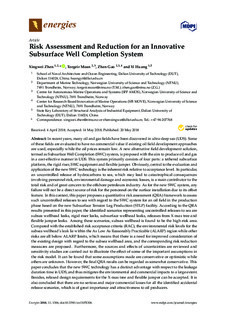| dc.description.abstract | In recent years, many oil and gas fields have been discovered in ultra-deep sea (UDS). Some of these fields are evaluated to have no commercial value if existing oil field development approaches are used, especially while the oil prices remain low. A new alternative field development solution, termed as Subsurface Well Completion (SWC) system, is proposed with the aim to produce oil and gas in a cost-effective manner in UDS. This system primarily consists of four parts: a tethered subsurface platform, the rigid riser, SWC equipment and flexible jumper. Obviously, central to the evaluation and application of the new SWC technology is the inherent risk relative to acceptance level. In particular, an uncontrolled release of hydrocarbons to sea, which may lead to catastrophical consequences involving personnel risk, environmental damage and economic losses, is a main contributor to the total risk and of great concern to the offshore petroleum industry. As for the new SWC system, any failure will not be a direct source of risk for the personnel on the surface installation due to its offset feature. In this context, this paper proposes a quantitative risk assessment (QRA) framework to assess such uncontrolled releases to sea with regard to the SWC system for an oil field in the production phase based on the new Subsurface Tension Leg Production (STLP) facility. According to the QRA results presented in this paper, the identified scenarios representing uncontrolled releases to sea are subsea wellhead leaks, rigid riser leaks, subsurface wellhead leaks, releases from X-mas tree and flexible jumper leaks. Among these scenarios, subsea wellhead is found to be the high-risk area. Compared with the established risk acceptance criteria (RAC), the environmental risk levels for the subsea wellhead’s leak lie within the As Low As Reasonably Practicable (ALARP) region while other risks are all below ALARP limits, which means that there is a need for improved consideration of the existing design with regard to the subsea wellhead area, and the corresponding risk reduction measures are proposed. Furthermore, the sources and effects of uncertainties are reviewed and sensitivity studies are carried out to illustrate the effect of some of the important assumptions in the risk model. It can be found that some assumptions made are conservative or optimistic while others are unknown. However, the final QRA results can be regarded as somewhat conservative. This paper concludes that the new SWC technology has a distinct advantage with respect to the leakage duration time in UDS, and thus mitigates the environmental and commercial impacts to a large extent. Besides, relaxed design requirements for the X-mas tree and flexible jumper can be accepted. It is also concluded that there are no serious and major commercial losses for all the identified accidental release scenarios, which is of great importance and attractiveness to oil producers. | nb_NO |

